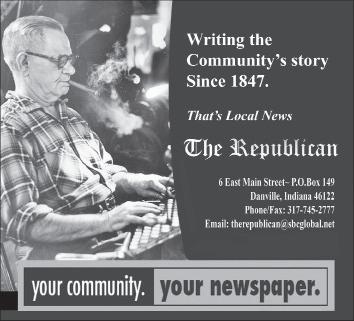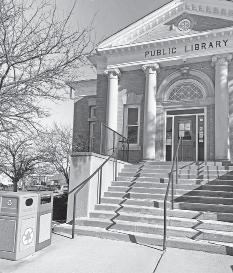
3 minute read
Paul Miner
Delving Into Yester~Year
Local historian and writer Paul Miner uses items from The Republican’s Yester- Year column to develop an interesting, informative and often humorous article.
Advertisement
1879 that title to more than half of county real estate was “defective.”
To the Editor: An article appearing Feb. 20, 1896, disclosed a “trace of ground” on the corner of the Square had been sold for $2,000, “a fair valuation,” to the First National Bank. Danville was growing. Yet all may not have been well across the county for years. Marshall Todd, abstractor of titles in the county recorder’s office declared in April
Might there be a chance I could reclaim the land wealth wrongly stripped from my ancestors all those years ago? Even if they didn’t live in this state? If the land my family eventually did buy here didn’t legally belong to the sellers, aren’t we due at least a substantial refund? For mental anguish and undue suffering? And high taxes? I wonder. Todd said it again two years later. More than 100 southern New York farms declared “worn out” were being sold by one agent in October 1881. The Republican mused whether if county land was advertised as it should be, “we might secure a liberal share” of those failing farmers. I wonder if they’d wear out their next farms. Land a quarter-mile south of Cartersburg “on the pike” was sold at public auction from the Court House north door from noon until 3 p.m. in January 1882. I’d have to be county surveyor David Gaston to adequately pinpoint the tracts totaling 82-1/2 acres, what with all those ranges, rods, sections and quarters cited.
Standing three hours in the cold outside that door, prospective buyers had to be shivering down to their union suits.
Bidders stood for six hours outside a Court House door for a late March 1882 Sheriff’s sale. Some $290 was due, plus interests and costs, and if the money from “rents and profits” was not raised, the acre in town would be sold.
What happened, I cannot say, but now imagine standing six hours in bad weather in a dry town.
That month, the paper reported vaccine farms were “just now, the most profitable real estate.”
I’d never heard about it. Those farms were used to raise animals to meet the demand to produce large amounts of “animal vaccine” to combat smallpox.
The approach was safer than “arm-to-arm” vaccines which could transmit syphilis, I discovered.
Also, that month, it appeared Indiana was to be “cursed” with a lottery, kettledrums were no longer “very popular” in Washington State, a Vermont town daily manufactured 50,000 slate pencils, glass burial cases were now “proper” in Connecticut and poet John Greenleaf Whittier used as a bookmark a tail from a gray squirrel that his cat killed.
That old six-hour sheriff’s sale came around again in November 1884, this time involving $9.53. If I had to guess, someone came up with a ten-spot. The following month, a more respectable $520.06 was on the line.
“Something new for our staid old town” was happening in mid-1882. A real estate man said more property was changing “than he has known for years.”
But townsfolk were consistent “fixtures.” They settled in when they arrived 20-50 years earlier.
They built to suit their tastes, “however much they might conflict with the different styles of architecture, and then . . .” they adorned “these architectural paradoxes.”
Danville became “quaint” and “down home.” Conservatism was inherited and Danville remained unchanged and secluded for decades.
“The star of empire left but a few lingering rays as it wended its way westward.” Moreover, “the iron horse” to Danville’s north and south “did not waken the old town.”
When war came, “the tramp of the boys” roused Danville. More than half a dozen subsequent conflicts kept the town awake.
Time and real estate movement reflected “the ushering in of an era that will bring wondrous changes in a few years.” I can’t think what that might be. Wondrous? Danville’s homes were responsible for its “good morals,” and they made it “a temperate town.” I don’t get that. Danville would improve and its homes “made handsomer.” They would be “better ventilated, neater, more convenient” and more comfortable. The town would grow and be the home of “hundreds of intelligent, healthy, handsome and hospitable residents.” I worry about the rest.
Paul Miner Lizton
______________________________________________________________________ _










